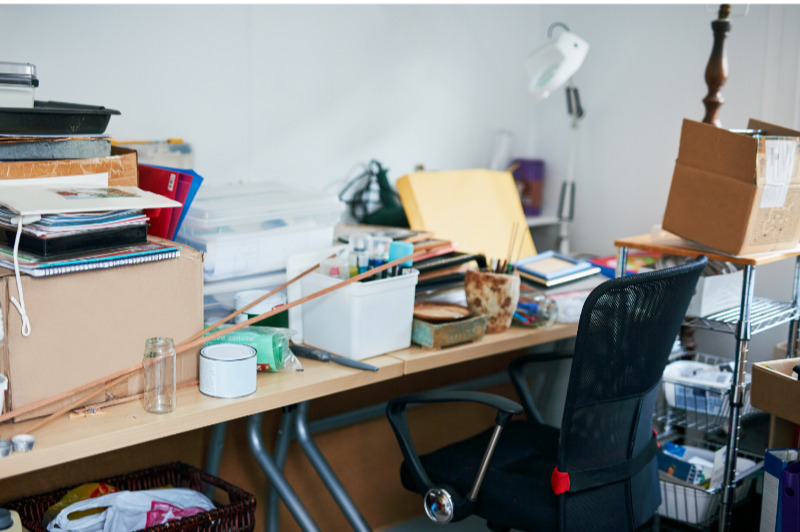by Jill Katz
One to Zen Organizing

The Story
Have you ever had this experience? Your sister and her husband are coming over to stay for a week and your guest room is a mess. So the day before their arrival you run around the guest room throwing all the piles into boxes and bags which you stack in the closet or in the corner of the room.
Or how about this? You get home from dinner at a restaurant with the kids and you throw the restaurant tote filled with coloring books and other activities in the corner of the mudroom and then forget about it.
Perhaps this happens to you? You go to a 3-day conference where you talk with colleagues and attend insightful presentations. You collect binders, handouts, business cards and swag. When you get home, you put the conference bag in the corner of your office where you proceed to look at it from time to time anxiously over the next few months.
As an organizer, I see these boxes and bags in many client’s homes in Home Offices, Guest rooms, Bedrooms, you name it. And this past year, I finally had a client give name to it: She referred to these bags as “Doom Bags” or "Doom Boxes."
Definition
When I got home I looked up the word “doom bag” which led me to its more common term, “doom box” which is defined as a:
“Box of various stuff, often gathered over time. Doom boxes originate from cleaning sprees under time pressure. Usually it is the intention of a doom box creator to postpone organizing the stuff in a doom box.”
The term is even used an acronym for "Didn't Organize, Only Moved".
Why do doom boxes happen?
In order to make these doom boxes and bags go away, we need to first uncover why this phenomenon is happening. I have distilled it down to 3 reasons:

-
Overwhelm: Individuals with neurodiverse traits may struggle with executive functioning, making it challenging to plan and initiate tasks, such as decluttering. Difficulty making decisions is another reality for the neurodiverse brain. The thought of tackling a cluttered space can be overwhelming, leading to avoidance and the creation of Doom Boxes.
-
Hyperfocus: On the flip side, some neurodiverse individuals may hyperfocus on particular tasks or interests, making it difficult to shift attention to tidying up and decluttering. This intense focus can lead to the neglect of the physical environment.
So while doom bags can be created by all, we are more likely to see them in homes with neurodivergent people.
10 Tips To Help Banish Those Doom Boxes
OK, so now you know what doom boxes are and why they are accumulating in your home. So what’s the next step? Here are some tips to help you deal with or at least, make peace, with your doom boxes:

1. Embrace your neurodiversity
Doom Boxes showcase the way your mind works. You need to get items out of the way quickly to make space. This is not a moral failing!
2. Create Awareness
Awareness is the first step to decluttering. Make a list of areas where you want to eliminate piles of doom.
Attack those doom bags by breaking the work into smaller steps by setting a timer. Use the Pomodoro technique to maintain focus.
4. Use Sensory friendly containers/tools
Use gloves to handle annoying tactile messes, Take items out of their space one small pile at a time when decluttering so visual clutter doesn’t stop you from putting things away.
5. Rewards
Give yourself a treat for working through those doom bags: read a good book, eat a piece of chocolate, talk a walk in nature, whatever works as a healthy reward.
6. Accountability
Work through the doom clutter with a friend, family member or professional organizer. Use an accountability app such as focusmate.
7. Create zones for special interests
If these items have a home, they are less likely to accumulate in doom bags and boxes.
8. Take photos of sentimental items
Take photos of sentimental items so you don’t feel you need to keep every single thing.
9. Create rules around categories that get you stuck
For example, showcase your birthday cards for the week or month of your birthday and then either discard or put in a special box dedicated to sentimental cards.
10. Experiment, by building on your other successes
Look at the most functional area of your home and think about how you made that area work for you and try to replicate the strategy. Don't beat yourself up about techniques that work for others but not for you. Remember to have a neurodiversity-focused approach which means it’s customized to fit your brain.
IN CONCLUSION
Remember, the goal is not just to eliminate Doom Boxes but to make peace with them. By acknowledging and working with the intricacies of your neurodiverse brain, you can create an organized and functional space that respects your unique self. So, next time you encounter a Doom Bag, approach it not with dread but with the understanding that it's a part of your journey towards a more harmonious living environment.
Do you have doom boxes in your home? Please share your story or tips with me in the comments section. I would love to hear about it!
For more information, contact Jill Katz.